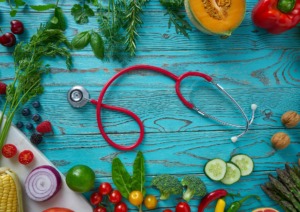 Typically, the Australian diet consists of a high intake of animal protein, sodium, and saturated fats. When combined with low intakes of potassium, magnesium, and bicarbonates, which help alkalise the body, such diet may induce a state of acidosis. This is a far cry from what our ancestors consumed, which consisted of an abundance of alkalizing nutrients. When acidosis becomes chronic, the renal and respiratory systems become stressed, and the skeletal system becomes demineralised, resulting in harmful effects to one’s health.
Typically, the Australian diet consists of a high intake of animal protein, sodium, and saturated fats. When combined with low intakes of potassium, magnesium, and bicarbonates, which help alkalise the body, such diet may induce a state of acidosis. This is a far cry from what our ancestors consumed, which consisted of an abundance of alkalizing nutrients. When acidosis becomes chronic, the renal and respiratory systems become stressed, and the skeletal system becomes demineralised, resulting in harmful effects to one’s health.
It can be quite confusing to classify food whether it is acidifying or alkalasing because their chemical nature does not necessarily depict the net effect on the bodily pH. Food gets oxidized, forming water, carbon dioxide, and inorganic compounds, which when formed will determine whether it is acidifying or alkalising. Some acidic foods such as lemons and apple cider vinegar actually form inorganic compounds that are alkaline when metabolised, thus creating an alkalising effect. Chloride, phosphorous, and sulphur are anions that contribute to the acid forming ability of food. While cations that identifies the base forming ability are sodium, potassium, calcium, and magnesium. It can be concluded that foods that have high levels of these cations will inherently have an alkaline effect. Not all foods that are tagged as “healthy” are alkalising.
Mineral supplements coupled with dietary interventions may compensate for increased hydrogen ions in the blood. Mineral citrate and bicarbonate supplements can protect the body against deteriorating pH levels by acting as buffers, metabolising and excreting excess acids in the long run.
For a balanced acid-alkaline diet, the golden rule is to go 80:20. That is, 80% must be “alkaline food”, and 20% must be “acidic food”:
Akaline Foods:
- Vegetables: Asparagus, artichoke, cabbage, lettuce, onion, cauliflower, radish, swede, peas, zucchini, lee, watercress, spinach, turnip, carrot, green beans, beetroot, garlic, celery, cucumber, broccoli, kale, Brussel sprouts.
- Fruits: Lemon, lime, avocado, tomato, grapefruit, watermelon (neutral), rhubarb
- Drinks: Fresh vegetable juice, distilled/ionised water, citrus water, herbal tea, vegetable broth, non-sweetened soy milk, almond milk
- Seeds, Nuts, Grains: Almonds, pumpkin seeds, sunflower seeds, sesame seeds, flax seeds, buckwheat, spelt, other sprouted seed
- Fats, Oils: Flax seed oil, hemp oil, avocado oil, olive oil, evening primrose oil, borage oil, coconut oil
- Others: sprouts (alfalfa, mung bean, little radish, chickpea, broccoli, etc), grasses (wheat, barley, kamut, etc), tahini, lentils, organic apple cider vinegar, Apple cider vinegar, herbs and spices.
Acidic Foods:
- Meat/Protein: Pork, lamb, beef, chicken, turkey, crustaceans, seafood (other than small and oily fish), eggs
- Dairy: Milk, cheese, cream, yogurt, ice cream
- Drinks: Soft drinks, coffee, tea (traditional), beers, spirits, fruit juice
- Fats, Oils: Saturated fats, hydrogenated oils, margarine, corn oil, vegetable oil, sunflower oil
- Fruits: All fruits aside from those listed as alkaline
- Seeds, Nuts: Peanuts, cashews, pistachios
- Others: white pasta, white bread, wholemeal bread, biscuits, condiments (tomato sauce, mayonnaise, etc), artificial sweeteners, honey
Key Points to Remember:
- Eat a variety of mostly alkalising foods daily, including salads, fresh veggies and healthy nuts/oils.
- Eat plenty of raw foods.
- Ensure an intake of about 2-3 litres of clean, pure water everyday.
- Consume acidic foods together with alkaline foods, in order to reduce the acidic effect. For example, vegetable salad with meat or seafood.
- Avoid packaged foods which often consists of hidden offenders such as sugars and salts.
- Don’t over cooking as this will reduce the nutrient content.
- Reduce the amount of acidic food and stay away from fatty meats, dairy, sweets, chocolates, alcohol, and tobacco.
Have some questions? Need help with what is the best nutrition designed specifically for you? Feel free to get in touch.
More on the body’s pH:
pH And Health (Part 1 of 4): Upsetting the Balance
